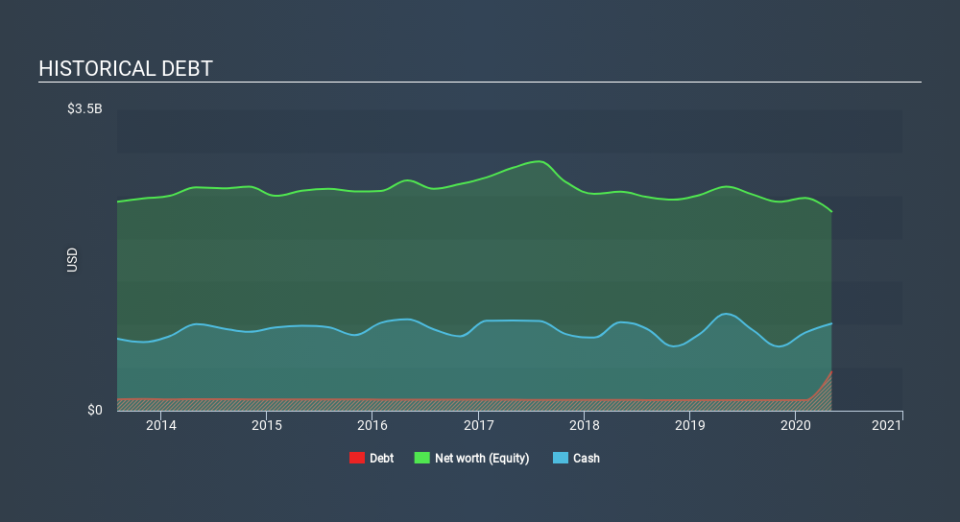We Think Foot Locker (NYSE:FL) Is Taking Some Risk With Its Debt

Howard Marks put it nicely when he said that, rather than worrying about share price volatility, 'The possibility of permanent loss is the risk I worry about... and every practical investor I know worries about. So it seems the smart money knows that debt - which is usually involved in bankruptcies - is a very important factor, when you assess how risky a company is. As with many other companies Foot Locker, Inc. (NYSE:FL) makes use of debt. But should shareholders be worried about its use of debt?
When Is Debt A Problem?
Generally speaking, debt only becomes a real problem when a company can't easily pay it off, either by raising capital or with its own cash flow. In the worst case scenario, a company can go bankrupt if it cannot pay its creditors. While that is not too common, we often do see indebted companies permanently diluting shareholders because lenders force them to raise capital at a distressed price. Having said that, the most common situation is where a company manages its debt reasonably well - and to its own advantage. The first step when considering a company's debt levels is to consider its cash and debt together.
View our latest analysis for Foot Locker
How Much Debt Does Foot Locker Carry?
As you can see below, at the end of May 2020, Foot Locker had US$451.0m of debt, up from US$123.0m a year ago. Click the image for more detail. However, it does have US$1.01b in cash offsetting this, leading to net cash of US$561.0m.
A Look At Foot Locker's Liabilities
The latest balance sheet data shows that Foot Locker had liabilities of US$1.64b due within a year, and liabilities of US$2.84b falling due after that. On the other hand, it had cash of US$1.01b and US$101.0m worth of receivables due within a year. So its liabilities total US$3.37b more than the combination of its cash and short-term receivables.
Given this deficit is actually higher than the company's market capitalization of US$3.03b, we think shareholders really should watch Foot Locker's debt levels, like a parent watching their child ride a bike for the first time. In the scenario where the company had to clean up its balance sheet quickly, it seems likely shareholders would suffer extensive dilution. Foot Locker boasts net cash, so it's fair to say it does not have a heavy debt load, even if it does have very significant liabilities, in total.
It is just as well that Foot Locker's load is not too heavy, because its EBIT was down 46% over the last year. Falling earnings (if the trend continues) could eventually make even modest debt quite risky. When analysing debt levels, the balance sheet is the obvious place to start. But ultimately the future profitability of the business will decide if Foot Locker can strengthen its balance sheet over time. So if you want to see what the professionals think, you might find this free report on analyst profit forecasts to be interesting.
But our final consideration is also important, because a company cannot pay debt with paper profits; it needs cold hard cash. Foot Locker may have net cash on the balance sheet, but it is still interesting to look at how well the business converts its earnings before interest and tax (EBIT) to free cash flow, because that will influence both its need for, and its capacity to manage debt. Over the most recent three years, Foot Locker recorded free cash flow worth 74% of its EBIT, which is around normal, given free cash flow excludes interest and tax. This cold hard cash means it can reduce its debt when it wants to.
Summing up
While Foot Locker does have more liabilities than liquid assets, it also has net cash of US$561.0m. The cherry on top was that in converted 74% of that EBIT to free cash flow, bringing in US$68m. So although we see some areas for improvement, we're not too worried about Foot Locker's balance sheet. When analysing debt levels, the balance sheet is the obvious place to start. But ultimately, every company can contain risks that exist outside of the balance sheet. Be aware that Foot Locker is showing 2 warning signs in our investment analysis , you should know about...
If you're interested in investing in businesses that can grow profits without the burden of debt, then check out this free list of growing businesses that have net cash on the balance sheet.
Love or hate this article? Concerned about the content? Get in touch with us directly. Alternatively, email editorial-team@simplywallst.com.
This article by Simply Wall St is general in nature. It does not constitute a recommendation to buy or sell any stock, and does not take account of your objectives, or your financial situation. We aim to bring you long-term focused analysis driven by fundamental data. Note that our analysis may not factor in the latest price-sensitive company announcements or qualitative material. Simply Wall St has no position in any stocks mentioned. Thank you for reading.

